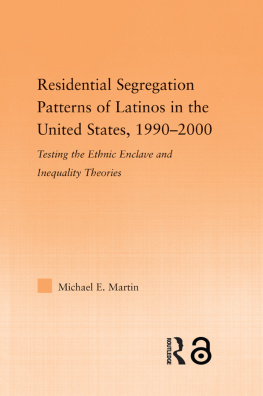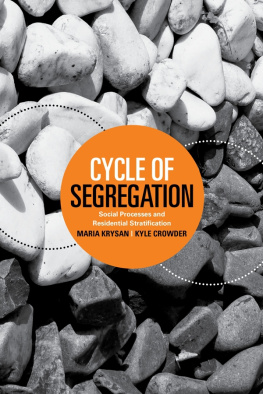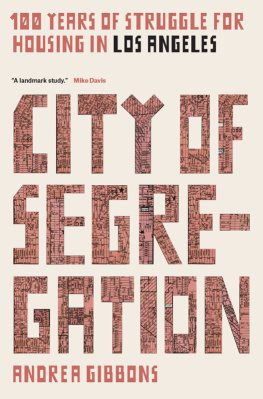Linking Integration and Residential Segregation
Policy-makers tend to view the residential segregation of minority ethnic groups in a negative light as it is seen as an obstacle to their integration. In the literature on neighbourhood effects, the residential concentration of minorities is seen as a major impediment to their social mobility and acculturation, while the literature on residential segregation emphasises the opposite causal direction, by focusing on the effect of integration on levels of (de-)segregation.
This volume, however, indicates that the link between integration and segregation is much less straightforward than is often depicted in academic literature and policy discourses. Based on research in a wide variety of western countries, it can be concluded that the process of assimilation into the housing market is highly complex and differs between and within ethnic groups. The integration pathway not only depends on the characteristics of migrants themselves, but also on the reactions of the institutions and the population of the receiving society. Linking Integration and Residential Segregation exposes the link between integration and segregation as a two-way relationship involving the minority ethnic groups and the host society, highlighting the importance of historical and geographical context for social and spatial outcomes.
This book was originally published as a special issue of the Journal of Ethnic and Migration Studies.
Gideon Bolt is Assistant Professor of Urban Geography, Methods and Techniques in the Faculty of Geosciences at Utrecht University, he Netherlands. His research focuses on urban policy, residential segregation and neighbourhood choice. Bolt is an editor of the Journal of Housing and the Built Environment and Tijdschrift voor de Volkshuisvesting [Journal of the Housing Sector].
A. Sule zekren is a Professor in the Faculty of Architecture at Istanbul Technical University, Turkey. Her research focuses on the housing and residential segregation of minority ethnic groups. zekren is one of the co-ordinators of the ENHRs working group on minority ethnic groups and housing. She is on the Advisory Board of the International Journal of Urban Policy.
Deborah Phillips is a Reader in Ethnic and Racial Studies in the School of Geography at the University of Leeds, UK, and also holds a lectureship at Jesus College Oxford. She has published widely on aspects of race, ethnicity and cultural difference, including discourses on ethnic segregation and integration, community cohesion, housing welfare and debates surrounding citizenship and belonging.
First published 2012
by Routledge
2 Park Square, Milton Park, Abingdon, Oxon, OX14 4RN
Simultaneously published in the USA and Canada
by Routledge
711 Third Avenue, New York, NY 10017
Routledge is an imprint of the Taylor & Francis Group, an informa business
2012 Taylor & Francis
This book is a reproduction of the Journal of Ethnic and Migration Studies, volume 36, issue 2. The Publisher requests to those authors who may be citing this book to state, also, the bibliographical details of the special issue on which the book was based.
All rights reserved. No part of this book may be reprinted or reproduced or utilised in any form or by any electronic, mechanical, or other means, now known or hereafter invented, including photocopying and recording, or in any information storage or retrieval system, without permission in writing from the publishers.
Trademark notice: Producte or corporate names may be trademarks or registered trademarks, and are used only for identification and explanation without intent to infringe.
British Library Cataloguing in Publication Data
A catalogue record for this book is available from the British Library
ISBN13: 978-0-415-50445-4
Typeset in Times New Roman
by Taylor & Francis Books
Publishers Note
The publisher would like to make readers aware that the chapters in this book may be referred to as articles as they are identical to the articles published in the special issue. The publisher accepts responsibility for any inconsistencies that may have arisen in the course of preparing this volume for print.
Contents
Gideon Bolt, A. Sule zekren and Deborah Phillips
Elvin K. Wyly, Deborah G. Martin, Pablo Mendez and Steven R. Holloway
Deborah Phillips
Sonia Arbaci and Jorge Malheiros
John Flint
Sabine Gruner
Robert Murdie and Sutama Ghosh
Talja Blokland and Gwen van Eijk
Gideon Bolt and Ronald van Kempen
Sule zekren and Ebru Ergoz-Karahan
Sonia Arbaci is Lecturer in Spatial Planning at University College London, UK.
Talja Blokland is Professor of Urban and Regional Sociology at Humboldt University of Berlin, Germany.
Gideon Bolt is Assistant Professor of Urban Geography at Utrecht University, the Netherlands.
Gwen van Eijk is Assistant Professor of Criminolgy at Leiden University, the Netherlands.
Ebru Ergoz-Karahan is Assistant Professor in Architecture at Istanbul Commerce University, Turkey.
John Flint is Professor of Town and Regional Planning at Sheffield Hallam University, UK.
Sutama Ghosh is Assistant Professor of Geography at Ryerson University, Toronto, Canada.
Sabine Gruner works as a psychotherapist in Marburg. The chapter emerged from her work as Research Assistant at the Technical University of Berlin, Germany.
Steven R. Holloway is Professor of Geography at the University of Georgia, USA.
Ronald van Kempen is Professor in Urban Geography at Utrecht University, the Netherlands.
Jorge Malheiros is Lecturer in Geography at the University of Lisbon, Portugal.
Deborah G. Martin is Assistant Professor of Geography at Clark University, USA.
Pablo Mendez is Post-doctoral fellow of Urban Geography at the University of British Columbia, Canada.
Robert Murdie is Professor Emeritus of Geography and Senior Scholar at York University, Toronto, Canada.
A. Sule zekren is Professor in the Faculty of Architecture at Istanbul Technical University, Turkey.
Deborah Phillips is Reader in Geography at the University of Leeds, UK and Lecturer at Jesus College, Oxford.
Elvin K. Wyly is Associate Professor of Geography at the University of British Columbia, Canada.
Gideon Bolt, A. Sule zekren and Deborah Phillips
In the introduction to this special issue of JEMS, we question the strong link which is often made between the integration of minority ethnic groups and their residential segregation. In the literature on neighbourhood effects, the residential concentration of minorities is seen as a major obstacle to their integration, while the residential segregation literature emphasises the opposite causal direction, by focusing on the effect of integration on levels of (de-)segregation. The papers in this special issue, however, indicate that integration and segregation cannot be linked in a straightforward way. Policy discourses tend to depict residential segregation in a negative light, but the process of assimilation into the housing market is highly complex and differs between and within ethnic groups. The integration pathway not only depends on the characteristics of migrants themselves, but also on the reactions of the institutions and the population of the receiving society.





